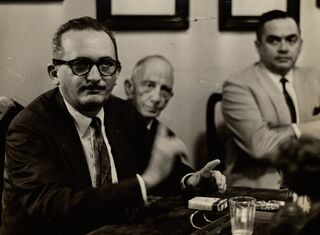Education
Developing a More Restorative Pedagogy
Can classroom communities take control over their own conflicts?
Posted October 4, 2022 Reviewed by Michelle Quirk
Key points
- There are good reasons why most conflicts are not handled in the classroom but, rather, are handed over to an outside authority.
- This appeal to an outside authority also has limitations, especially in a class that is focused on conflict and justice.
- Opting out of institutional conflict management expectations is likely to be difficult; it's useful to engage students in the pros and cons.
Critical pedagogy, an educational philosophy that invites students to critique and challenge systems of power and oppression, was originally developed by Brazilian educator Paolo Freire in 1968, but has its roots in critical theory, which goes back even further.

Critical Pedagogy Background
As part of his critique of the traditional education system, Freire referred to the banking model of education as one in which the instructor makes deposits of knowledge into passive students who receive, file, and store the deposits but do not question the information, build on it, or adapt it to a different context. Thus, Freire argued for a more egalitarian power structure between teachers and students, a more participatory student body, and a much larger emphasis on critical thinking and problem-solving.
In addition, Freire and other critical theorists such as bell hooks espoused a commitment to learning from the vast and diverse experiences of people around the globe and challenged the notion that every student should be taught the same things, arguing for a more personalized approach based on individual and cultural differences (Burke, 2004). To that end, Freire, hooks, and other advocates of critical pedagogy emphasize that teachers must also remain in the role of learners, not only in regard to their content area but also in terms of learning and understanding the cultural, racial, and class-based experiences of their students, as well as their own biases and prejudices (Freire, 2018; Burke, 2004).
Freire’s ideas fit well with the student-centered movement built on the scholarship of John Dewey and Lev Vygotsky and championed, among others, by Carl Rogers and Maria Montessori. However, in his later years, Freire grew concerned that teachers were using his work to justify giving up their authority in ways that he considered dishonest:
When teachers call themselves facilitators and not teachers, they become involved in a distortion of reality….the teacher turned facilitator maintains the power institutionally created in the position….The facilitator still grades, still has certain control over the curriculum, and to deny these facts is to be disingenuous….What one cannot do in trying to divest of authoritarianism is relinquish one’s authority as teacher….Teachers maintain a certain level of authority through the depth and breadth of knowledge of the subject matter that they teach (Freire & Macedo, 1995, p. 378).
In that same spirit, Freire rejected the notion that teachers should aspire to be non-directive or even less directive. To the contrary, he believed educators should use their structural authority to get students involved in planning their education and help them build their capacity to engage with the content critically rather than passively (Freire & Macedo, 1995).
Restorative Justice
While there is no single approach to critical pedagogy, restorative justice principles are congruent with the broad philosophy of critical pedagogy and, as such, provide one conceptual approach to critical pedagogy implementation. Furthermore, for those who are teaching restorative justice, integrating restorative principles into pedagogy (rather than merely teaching about them) allows the learning environment to be more congruent with restorative values and principles and gives students an opportunity to have first-hand experience with those principles. In a recent book chapter, I discuss how 10 such principles can be reflected in pedagogical practices. In this blog post, I focus on just one:
Conflicts Belong to the Community
From the moment that Nils Christie first delivered his conflicts as property talk in 1976, his assertion that conflicts belong to the community, rather than to government officials or institutional professionals, has been a core principle of the restorative movement. Christie’s paper of the same title (Christie, 1977) is the first assigned reading in the course and creates an opportunity to not only consider the costs of handing our conflicts over to professionals but also the benefits and costs of keeping the conflicts in the community.
As part of this discussion, I ask students to consider whether it might make sense for our class to create our own conflict/justice system that we can turn to instead of relying on the grievance-based justice processes available in the department and university. This is an important conversation because, without it, there is an unacknowledged incongruence between the restorative content of the course and the available options for dealing with classroom conflict. In truth, there are good reasons for this incongruence and good reasons not to attempt to eliminate it.
The good reasons that dominant (non-restorative) systems are set up to remove serious and moderate conflicts from the classroom (and have them responded to by department administrators or a designated campus office) include protecting students from the instructor’s structural power and protecting learning time from the time demands of conflict resolution. As well, it places the conflict in the hands of those who have the training and experience to, at least in theory, make decisions that are in the best interest of both the involved parties and the campus community.
But this appeal to an outside authority also has limitations, especially in a class that is focused on conflict and justice. Among these are that
- Students lose the opportunity to practice conflict- and problem-solving skills to apply the curriculum to their own lived experience, which Galtung (2008) argued is an essential part of peace education;
- The professionals who are charged with sorting out the conflicts are removed from the specific classroom context in which the conflict emerged, which means they may not get an accurate understanding of what happened, including the different types of harm that might have occurred;
- Our institutions are rule- and punishment-focused, while a restorative justice class (in theory) has the ability and motivation to focus on harm and how to repair it; and
- Handing over the conflicts to the department and/or university actually disempowers the harmed party if the wishes of those who were harmed run counter to university punishment guidelines.
Even if we wanted to, the students and I do not have the authority to simply opt out of the university system. This not only means that students would still have the option of filing a formal grievance but also that we would not be able to count on either the department or campus supporting whatever agreements our class justice system might reach. While this does not preclude us from creating a justice system of our own, which in a way is what every class does when it establishes (or receives from the instructor) class “discussion guidelines,” it does mean that anything we do to that end is embedded in the larger systems of the university and, therefore, is constrained by those systems.
Because of these constraints, I am more interested in having a dialogue that names and engages the incongruence and unearths this complexity than I am in actually creating something that may appear to be more restorative but is still subject to university policies and to the professionals responsible for administering them. Yet, even with these considerable constraints, by having students collectively consider the possibility of creating their own justice system and explore what they might have to win and lose in the process, we not only create a bit more congruence with this particular principle but also create an opportunity for students to share power and have more agency in defining classroom norms (Zeiser, Scholz, & Cirks, 2018). Moreover, the discussion typically makes the restorative values and practices more salient, potentially creating more openness to talking through the disagreements that naturally arise when there is honest dialogue about contentious content.
In some ways, the entire conversation is a kind of collective thought experiment. So far, the class has never decided to actually create its own justice system, though there is always the possibility that one semester a critical mass of students will decide to do so. If that happens, a part of me will worry about how it will be perceived by department and institutional leadership, especially if the system is then used to work through real conflicts, but a part of me will be delighted to see students initiate such a process and curious to see what emerges. I suspect such tension is unavoidable when trying to do anything restorative within a hierarchical system.
References
Burke, B. (2004). Bell hooks on education. The encyclopedia of informal education. Retrieved from www.infed.org/mobi/bell-hooks-on-education.htm.
Christie, N. (1977). Conflicts as property. The British journal of criminology, 17(1), 1-15.
Freire, P. (2018). Pedagogy of the oppressed. Bloomsbury publishing USA.
Freire, P. & Macedo, D. (1995). A dialogue: Culture, language, and race. Harvard educational review, 65(3), 377-403.
Galtung, J. (2008). Form and content of peace education. Encyclopedia of peace education, 49-58.
Zeiser, K., Scholz, C., & Cirks, V. (2018). Maximizing Student Agency: Implementing and Measuring Student-Centered Learning Practices. American Institutes for Research.




